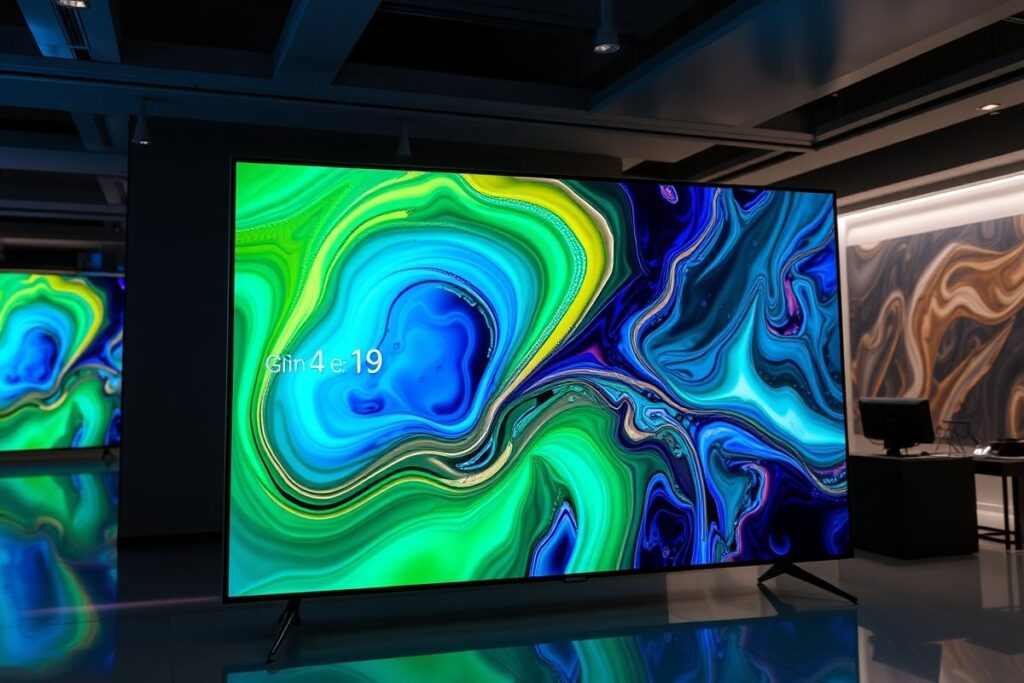The world of display technology is constantly evolving, and at the forefront of this evolution is Organic Light Emitting Diode (OLED) technology. Offering unparalleled contrast ratios, vibrant colors, and incredible flexibility, OLEDs have transformed how we experience everything from smartphones and televisions to wearable devices and automotive displays. But the journey of OLED innovation doesn’t stop there. Researchers and manufacturers are continuously pushing the boundaries of what’s possible, developing new materials, manufacturing processes, and display architectures that promise even more stunning visuals, improved efficiency, and exciting new applications. This article delves into the latest innovations in OLED technology, exploring the advancements that are shaping the future of displays.
Enhanced Efficiency and Brightness

The Rise of Phosphorescent and Thermally Activated Delayed Fluorescence (TADF) Materials
One of the key areas of focus in OLED development is improving efficiency and brightness. Traditional fluorescent OLEDs suffer from limitations in their internal quantum efficiency, meaning a significant portion of the generated light is lost. However, the introduction of phosphorescent materials has significantly boosted efficiency, allowing for brighter displays with lower power consumption. Furthermore, the emergence of Thermally Activated Delayed Fluorescence (TADF) materials offers a promising alternative, potentially achieving high efficiency without the use of expensive rare-earth metals commonly found in phosphorescent materials.
Phosphorescent OLEDs utilize heavy metal complexes to harvest both singlet and triplet excitons, achieving near 100% internal quantum efficiency. This advancement has been crucial for the widespread adoption of OLEDs in high-end displays. However, the reliance on rare-earth metals raises concerns about cost and sustainability.
TADF materials, on the other hand, offer a potential solution by harnessing a mechanism known as reverse intersystem crossing. This allows them to convert triplet excitons into singlet excitons, achieving high efficiency without the need for expensive metals. This makes TADF a promising area of research for the next generation of OLED displays.
Improving Light Extraction Techniques
Another avenue for enhancing brightness and efficiency lies in optimizing light extraction techniques. A significant portion of the light generated within an OLED device can be trapped due to total internal reflection. Researchers are exploring various methods to overcome this, including micro-lens arrays, photonic crystals, and surface plasmons. These techniques aim to redirect trapped light outwards, ultimately increasing the perceived brightness of the display while minimizing power consumption.
Micro-lens arrays placed on the surface of the OLED can help to redirect light outwards, reducing internal reflections. Photonic crystals, with their periodic nanostructures, can also manipulate the flow of light, enhancing light extraction efficiency.
Surface plasmons, which are oscillations of electrons at the interface between a metal and a dielectric, offer another promising approach. By carefully designing the metal nanostructures, researchers can couple the emitted light to surface plasmons and then outcouple it from the device, further improving light extraction.
Flexible and Transparent OLEDs
Bendable and Foldable Displays
The inherent flexibility of OLEDs has opened up exciting possibilities for bendable and foldable displays. Unlike traditional LCDs that rely on rigid backlights, OLEDs can be deposited on flexible substrates, allowing for curved screens and even devices that can be folded like a piece of paper. This flexibility is transforming the design of smartphones, tablets, and wearable devices, offering new form factors and user experiences.
Flexible OLEDs utilize plastic substrates instead of glass, enabling them to bend and conform to various shapes. This has led to the development of curved displays that offer a more immersive viewing experience.
Foldable displays take this flexibility to the next level, allowing devices to be folded in half, reducing their size and enhancing portability. This technology is paving the way for innovative smartphone designs and new possibilities in foldable tablets and laptops.
Transparent Displays: A Glimpse into the Future
Transparent OLEDs represent another exciting frontier in display technology. These displays allow light to pass through them, creating the potential for see-through screens that can be overlaid on real-world objects. Applications for transparent OLEDs range from heads-up displays in automobiles and augmented reality devices to interactive windows and smart appliances.
Transparent OLEDs achieve their transparency by using transparent electrodes and organic materials. This allows light to pass through the display, creating a see-through effect.
The potential applications for transparent OLEDs are vast, including heads-up displays that project information onto the windshield of a car, augmented reality devices that overlay digital information onto the real world, and interactive windows that can display information or control the transparency of the glass.
New Applications and Form Factors
Wearable Displays and E-Textiles
OLED technology is making significant strides in the realm of wearable devices. The flexibility and low power consumption of OLEDs make them ideal for integration into smartwatches, fitness trackers, and other wearables. Furthermore, research into OLED integration with textiles is paving the way for e-textiles, clothing embedded with displays and sensors that could revolutionize fashion and healthcare.
Automotive Displays and Lighting
OLEDs are also transforming the automotive industry. Their flexibility allows for curved and contoured displays that seamlessly integrate into the dashboard and interior of vehicles. Moreover, OLEDs are being explored for use in automotive lighting, offering unique design possibilities and improved safety features.
Conclusion
OLED technology continues to evolve at a rapid pace, with innovations constantly pushing the boundaries of what’s possible. From enhanced efficiency and brightness to flexible and transparent displays, OLEDs are transforming the way we interact with technology. As research and development continue, we can expect even more groundbreaking advancements in the years to come, further solidifying OLEDs’ position as the leading display technology of the future.

Leave a Reply